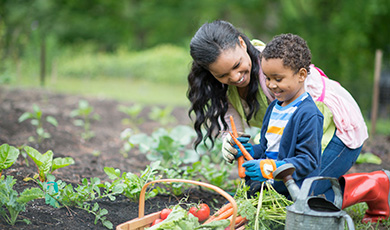Gardening Tips for a Delicious Harvest

Spring is just around the corner and that means it’s time to prepare for gardening season. If you want to get more fresh, healthy vegetables and fruits into your diet—and get some exercise—gardening is the ideal way to accomplish both goals. Plus, the taste of fresh produce from your own garden is hard to beat!
Whether you’re an experienced green thumb or just starting out, these tips can help your harvest!
Once you’ve prepped your soil, it’s time to decide what to plant and where you’ll place it. When you’re planning out your planting space, keep the following factors in mind:
Sun exposure (full sun, part sun, part shade, shade); with few exceptions, most vegetables need full sun
USDA Plant Hardiness Zone or Sunset Climate Zone and recommended planting dates for your area
Companion planting, or plants that complement each others’ growth
All of these factors will determine where you place your garden, which plants to choose, when to plant, how you organize plants within your garden, and any soil supplementation you may need. Harness the power of technology and take your garden planning online. Virtual garden planning software makes the planning process simple, from creating a layout to building a calendar.
Choosing Plants
Now comes the fun part: which plants to choose? For most gardeners, space constraints have the most influence. The key lies in discovering what works in your particular micro-climate; you may want to speak with neighbors who have gardening experience and ask them what’s worked and what hasn’t.
As a starting point for a 16-by-10-foot garden, the Old Farmer’s Almanac recommends planting:
Five tomatoes
Four zucchini squash
Six peppers
Up to 11 rows of cabbage, lettuce, beets, carrots, bush beans, chard, and radishes
Marigolds to ward off rabbits and other pests
These basic plants may feed a family of four for one summer. However, you can choose other favorite veggies and fruits to match your tastes; consider the produce you find yourself buying every time you visit the grocery store and focus on those plants. No matter which plants you choose, you may want to use a planting calendar to determine the right time of the month to start seeds, transplant seedlings, or purchase starts.
Companion Planting
Using the principles of companion planting, or placing plants in complementary positions within the garden, may also help boost your harvest. This method has been used for generations to enhance plant health and production. Some rules are quite simple, such as placing plants that thrive with a bit of shade under taller plants that will provide that shade. Some plants repel pests; for instance, tomatoes repel diamondback moth larvae, a pest that’s attracted to cabbage. Planting tomatoes and cabbage together may help keep the larvae away.
Other plants, known as nitrogen fixers, actually add beneficial nutrients to the soil. Legumes such as beans and peas are prolific nitrogen fixers that help to nourish plants around them. Use a companion plant chart to determine which plants can give each other a helping hand in your garden.
Try Regional Varieties
While there’s nothing wrong with purchasing seeds or starts at a big box store, most of the varieties sold are likely somewhat “generic,” in that they’re not necessarily tailored for success given your specific region’s weather patterns and soil types. Consider trying regionally specific varietals that have proven successful in your region. A national survey that looked into the most successful varieties across the U.S. may offer insight into what to try in your hometown.
Gardening can be an incredibly rewarding activity that promotes environmental sustainability, gives you some exercise, and provides delicious food for your family, too
This article provided by Encompass, a Bolder Insurance partner.
The general information contained in The Encompass Blog is provided as a courtesy, and is for informational and entertainment purposes only. The contents of this website are subject to periodic change without notice. Information provided on The Encompass Blog is not intended to replace official sources. Although attempts will be made to ensure that the information is accurate and timely, the information is presented “as is” and without warranties. Information contained on The Encompass Blog should not be mistaken for professional advice. Information contained herein should not be considered error-free and should not be used as the exclusive basis for decision-making. Use of website information is strictly voluntary and at the user’s sole risk. We encourage you to obtain personal advice from qualified professionals when making decision regarding your specific situation.
Other resources linked from these pages are maintained by independent providers. The Encompass Blog does not monitor all linked resources and cannot guarantee their accuracy. Statements, views and opinions included in an independent provider’s material are strictly those of the author(s). These views may not necessarily represent the opinions or policies of The Encompass Blog, the Encompass family of companies or its agents, officers or employees.






